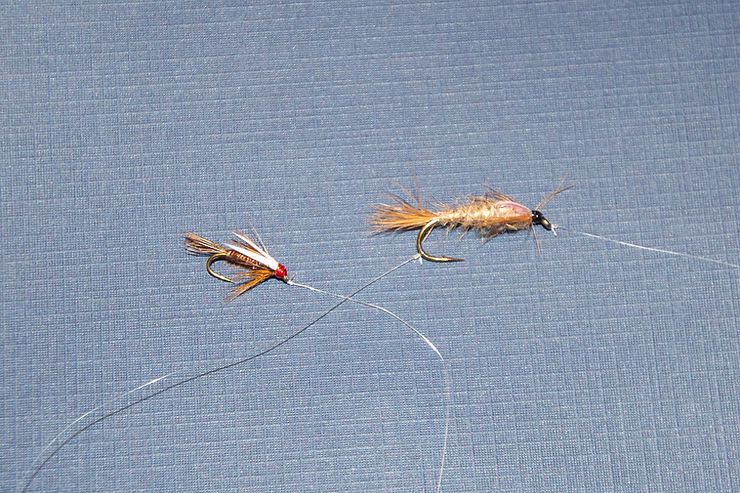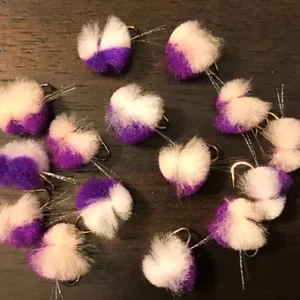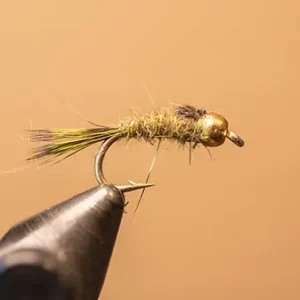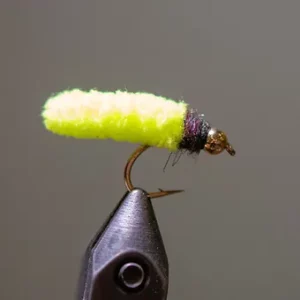One is Good, Two is Better: Using Tandem Rigs

I used to be a dedicated one-fly nympher, always fearing I’d spend more time untangling two flies on my leader instead of actually fishing. Last spring, though, I gave in and started fishing two nymphs, or as some call it “a tandem rig,” and my catch rates increased considerably — but not at first. It took some time to figure out how to rig the nymphs so they wouldn’t get tangled on every cast, how to adjust for water depth, and combinations that work well together.
Ask a dozen anglers and they’ll probably suggest a dozen different knots to use to attach flies to the leader. Some of them get pretty complicated. Personally, I’m just not that guy who likes to spend too much time rigging up, so I keep it as simple as possible. I start by tying a tippet ring to the end of my leader, usually with something like a palomar knot. This gives me a strong connection point for my tandem rig and provides some flexibility as far as being able to change tippet diameters and lengths without compromising the length of my leader.

I use an improved clinch knot to tie my tippet to the tippet ring, another improved clinch knot to attach the fly to the tippet, and then another improved clinch knot to tie another length of tippet to the bend of the hook of the first fly. I’ve experimented with triple surgeon knots to tie the second length of tippet above the first fly as a “tag” as well as tied it directly to the eye of the first nymph. In my experience, it doesn’t make a difference. Tying directly to the bend of the hook is the easiest, and quickest, way to get your nymphs in the water. The more complicated the rig, the better chance it will tangle during the cast.
Scaling down size with each length of tippet will save some flies, especially if you’re uncertain of water depth. In most situations, my first section of tippet is 4x or 5x, and the second section is one size smaller or lighter. If I snag a rock or other debris with the trailing fly, the lighter tippet breaks first and all I lose is the trailing fly instead of the whole rig.
There are no hard and fast rules concerning length of tippet between the two flies. I typically start with the flies about a foot apart so that I have some options if I have to change patterns. I rarely fish them less than six inches apart. Several times last year, I wasn’t getting much action, but when I lengthened the tippet between the flies to about a foot, I started picking up trout.
A lot depends on the mood of the fish and how aggressively they’re feeding. If they’re finicky, or perhaps even spooky, a longer tippet is usually preferred. I rarely go longer than a foot between flies, though, simply because I want both nymphs on the bottom or very close to it. If the connecting tippet is too long, the trailing nymph tends to get snagged more often.
An unlimited number of nymph combinations can be used on tandem rigs. As a general rule, I use the bigger, heavier fly as the lead fly, and a smaller, lighter trailer. Using the heavier fly as the trailer just drags bottom too much and I lose too many flies.
It’s easy to over-think which fly combinations to use. Common advice is to use two very different flies on a tandem rig, a bright attractor-type fly to catch the trout’s attention and a more natural trailing fly to seal the deal. Honestly, I don’t think color or style makes a bit of difference in whether one combination will outperform another. Several times, I’ve used a chartreuse Mop Fly with a hot pink Y2K trailer and did very well. Other times, I’ve used two Pheasants Tails together and did well. The most important factor is what you have confidence using and how you present it.
My preference is to use traditional patterns such as the Hare’s Ear, Prince Nymph, or Pheasant Tail in sizes 12 to 14 as the point fly because they imitate a number of insects found in almost every waterway. No matter what the conditions, if I’m using one of those patterns, I have a chance to catch fish. However, I do experiment a lot with the trailing nymph until I find something that works consistently.
Of course, if the point fly isn’t producing, I keep changing until I find one that does. Depending on the mood of the fish, sometimes it really does take a bright, attractor-type fly to catch their attention. That’s what makes fly fishing so fun. Trout react to patterns and techniques differently every day, and so each day presents a new opportunity to experiment and learn.
Once I started fishing tandem rigs, I found it almost impossible to go back to using a single nymph. Using two nymphs enables me to experiment and figure out more quickly which patterns are working that day. I guess it’s true that if one is good, two is better, at least when it comes to fly fishing with tandem rigs.
Sign up for the Dark Skies Fly Fishing e-newsletter
It's free, delivered to your inbox approximately three times each month. Your information is always kept private and used for the sole purpose of keeping you up to date on blog posts and specials in the online store.
Sign Up NowShop The Flies Mentioned In This Post
-
Egg Patterns
Y2K
$1.65 Select options This product has multiple variants. The options may be chosen on the product pageRated 0 out of 5 -
Flies
Hare’s Ear Nymph
$1.65 Select options This product has multiple variants. The options may be chosen on the product pageRated 0 out of 5 -
Flies
Mop Fly
$1.65 Select options This product has multiple variants. The options may be chosen on the product pageRated 0 out of 5 -
Flies
Prince Nymph
$1.65 Select options This product has multiple variants. The options may be chosen on the product pageRated 0 out of 5 -
Flies
Pheasant Tail Nymph
$1.65 Select options This product has multiple variants. The options may be chosen on the product pageRated 0 out of 5





